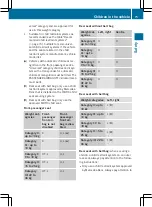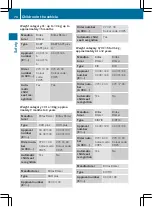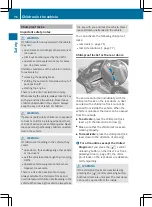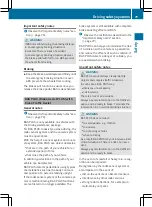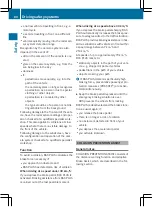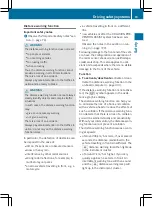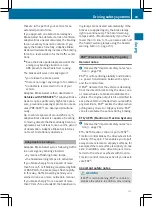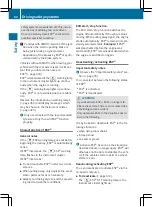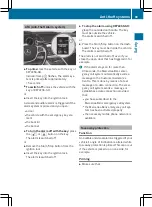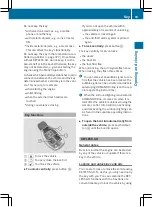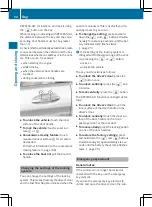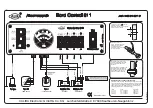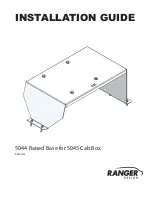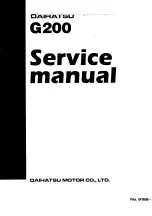
that are in the path of your vehicle for an
extended period of time.
If you approach an obstacle and adaptive
Brake Assist has detected a risk of collision,
adaptive Brake Assist calculates the braking
force necessary to avoid a collision. If you
apply the brakes forcefully, adaptive Brake
Assist will automatically increase the braking
force to a level suitable for the traffic condi-
tions.
X
Keep the brake pedal depressed until the
emergency braking situation is over.
ABS prevents the wheels from locking.
The brakes will work normally again if:
R
you release the brake pedal
R
there is no longer any danger of a collision
R
no obstacle is detected in front of your
vehicle
Adaptive Brake Assist is then deactivated.
Vehicles with PRE-SAFE
®
: if adaptive Brake
Assist requires particularly high brake pres-
sure, preventive passenger protection meas-
ures (PRE-SAFE
®
) are deployed simultane-
ously.
Up to vehicle speeds of around 250 km/h,
adaptive Brake Assist is capable of reacting
to moving objects that have already been rec-
ognised as such at least once over the period
of observation. Adaptive Brake Assist does
not react to stationary obstacles.
Adaptive brake lamps
Adaptive Brake Assist warns following traffic
in an emergency braking situation:
R
by means of flashing brake lamps
R
the hazard warning lamps are activated
If you brake sharply from a speed of more
than 50 km/h or if braking is assisted by BAS
or BAS PLUS, the brake lamps flash rapidly.
In this way, traffic travelling behind you is
warned in an even more noticeable manner.
If you brake sharply from a speed of more
than 70 km/h to a standstill, the hazard warn-
ing lamps are activated automatically. If the
brakes are applied again, the brake lamps
light up continuously. The hazard warning
lamps switch off automatically if you travel
faster than 10 km/h. You can also switch off
the hazard warning lamps using the hazard
warning button (
Y
page 151).
ESP
®
(Electronic Stability Program)
General notes
i
Observe the "Important safety notes" sec-
tion (
Y
page 78).
ESP
®
monitors driving stability and traction,
i.e. power transmission between the tyres
and the road surface.
If ESP
®
detects that the vehicle is deviating
from the direction desired by the driver, one
or more wheels are braked to stabilise the
vehicle. The engine output is also modified to
keep the vehicle on the desired course within
physical limits. ESP
®
assists the driver when
pulling away on wet or slippery roads. ESP
®
can also stabilise the vehicle during braking.
ETS/4ETS (Electronic Traction System)
i
Observe the "Important safety notes" sec-
tion (
Y
page 78).
ETS/4ETS traction control is part of ESP
®
.
Traction control brakes the drive wheels indi-
vidually if they spin. This enables you to pull
away and accelerate on slippery surfaces, for
example if the road surface is slippery on one
side. In addition, more drive torque is trans-
ferred to the wheel or wheels with traction.
Traction control remains active if you deacti-
vate ESP
®
.
Important safety notes
G
WARNING
If ESP
®
is malfunctioning, ESP
®
is unable to
stabilise the vehicle. In addition, other driving
Driving safety systems
83
Sa
fet
y
Z
Содержание 2013 S-CLASS
Страница 2: ......
Страница 3: ......
Страница 5: ......
Страница 33: ...30 ...
Страница 119: ...116 ...
Страница 163: ...160 ...
Страница 191: ...188 ...
Страница 372: ...Useful information 370 Stowage areas 370 Features 378 369 Stowing and features ...
Страница 402: ...Useful information 400 Engine compartment 400 ASSYST PLUS 405 Care 406 399 Maintenance and care ...
Страница 441: ...438 ...
Страница 489: ...486 ...
Страница 490: ...487 ...
Страница 491: ...488 ...
Страница 492: ......
Страница 493: ......



